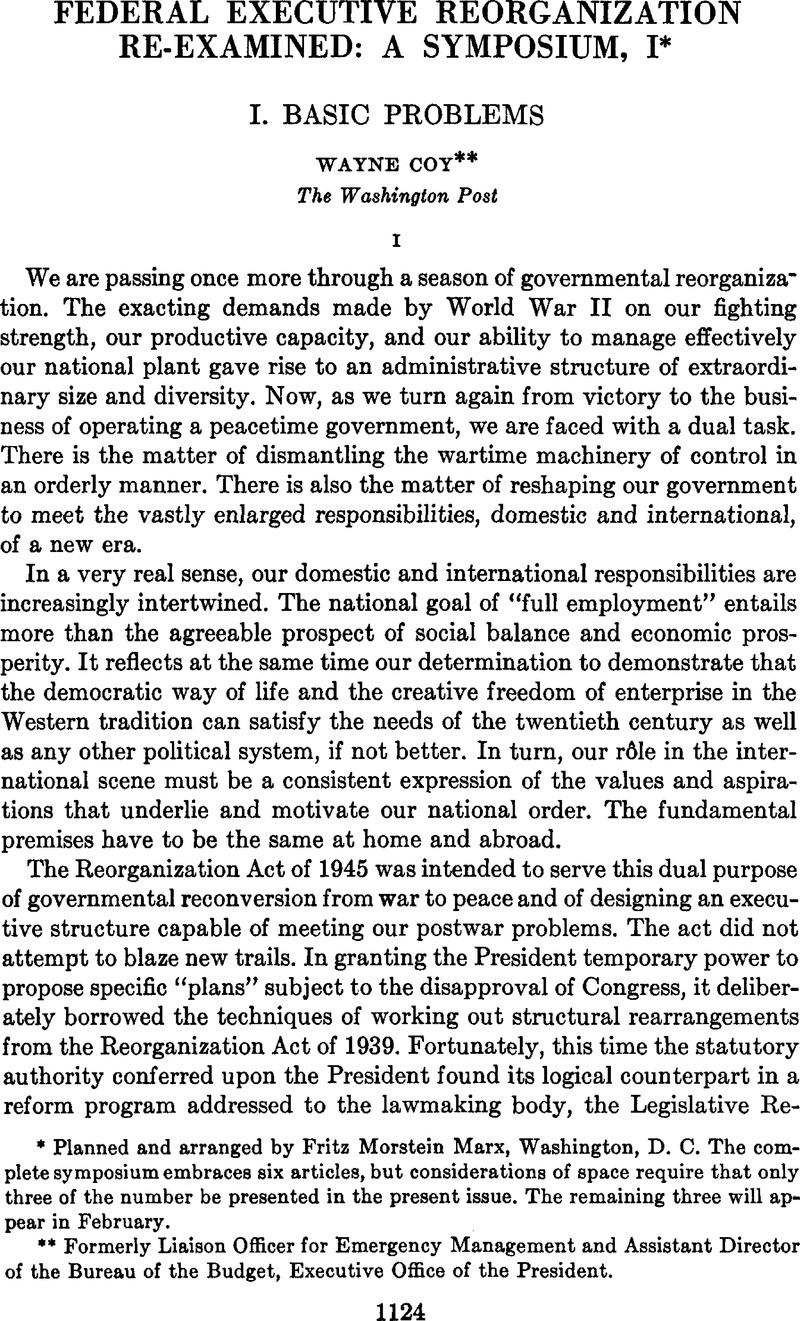Article contents
II. Wartime Currents and Peacetime Trends
Published online by Cambridge University Press: 02 September 2013
Abstract

- Type
- Federal Executive Reorganization Re-Examined: A Symposium, I
- Information
- Copyright
- Copyright © American Political Science Association 1946
References
1 See, for instance, Marx, Fritz Morstein, “The Bureau of the Budget; Its Evolution and Present Rôle,” in this Review, Vol. 39 (1945), pp. 653 ff., 869 ff.Google Scholar; Smith, Harold D., “The Budget as an Instrument of Legislative Control and Executive Management,” Public Administration Review, Vol. 4 (1944), pp. 181 ff.CrossRefGoogle Scholar
2 See Merriam, Charles E., “The National Resources Planning Board,” in this Review, Vol. 38 (1944), pp. 1075 ff.Google Scholar
3 Public Law No. 304, 79th Cong., 2d Sess.
4 See Brownlow, Louis and Others, “The Executive Office of the President: A Symposium,” Public Administration Review, Vol. 1 (1941), pp. 101 ff.CrossRefGoogle Scholar
5 Schmeckebier, Laurence F., “Organization of the Executive Branch of the National Government,” in this Review, Vol. 34 (1939), pp. 959 ff.Google Scholar; Vol. 35 (1940), pp. 450 ff., 650 ff., 1043 ff.
6 See Harris, Joseph P., “The Emergency National Defense Organization,” Public Administration Review, Vol. 1 (1940), pp. 1 ff.CrossRefGoogle Scholar
7 For this account of wartime experience, the writer has drawn heavily on the excellent forthcoming study, America at War, prepared by a special staff of the Budget Bureau. See also the able analysis by Guliek, Luther, “War Organization of the Federal Government,” in this Review, Vol. 38 (1944), pp. 1166 ff.Google Scholar
8 Public Law No. 395, 78th Cong., 2d Sess.
9 “Reconversion of the Federal Administrative Machinery from War to Peace,” Public Administration Review, Vol. 4 (1944), p. 316.
10 Public Law No. 263, 79th Cong., 1st Sess.
11 Sec. 5(a), par. 6.
12 In the subsequent debates on the President's reorganization plans, it was freely alleged by several members of the House, citing this provision, that Congress did not want the President to touch independent, bipartisan agencies.
13 See Millett, John D. and Rogers, Lindsay, “The Legislative Veto and the Reorganization Act of 1939,” Public Administration Review, Vol. 1 (1940), pp. 176 ff.CrossRefGoogle Scholar
14 See United States Government Manual, 1945, Appendix A, pp. 590–622; also Committee on the Judiciary of the Senate, Report No. 638 to accompany S. 1120, 79th Cong., 1st Sess., 1945.
15 Senate Committee on the Judiciary, Hearings on S. Con. Res. Nos. 64, 65, 66 79th Cong., 2d Sess., p. 32.
16 Isbrandtsen-Moller Co. v. U. S., 14 Fed. Supp. 407 (1936).
- 2
- Cited by





Comments
No Comments have been published for this article.